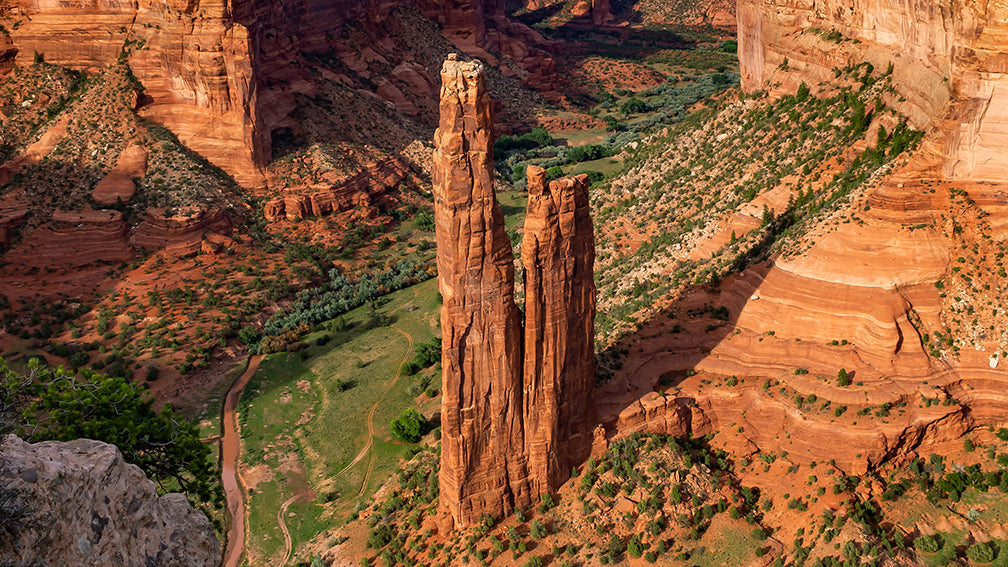National Monuments, Forests, and Lakeshores; Natural Treasures Near and Far
While National Park visitation numbers continue to soar to record-breaking levels, America's National Monuments, Forests, and Lakeshores receive fewer visitors while offering comparable natural beauty, national history, and cultural education. For those already planning this summer's family vacation, consider adding a National Monument, Forest, or Lakeshore to your trip roster. These beauties can be a great way to enjoy some of the country's most visually stunning and educational places.
To help you on your journey, we divided the U.S. into six distinct quadrants, choosing a National Monument, Forest, or Lakeshore in each. Read on to find out which one is nearest you!
The Southeast
Located in the Ozark National Forest, Whitaker Point is probably the most photographed nature site in Arkansas. The stunning rock outcropping juts out into the open air, affording hikers 360-degree views of the surrounding mountains. The Point is also called Hawksbill Craig for its hawk-like appearance.

Visitors to Whitaker Point often feel that the outcropping was intentionally created by Nature itself as a natural viewing area. Why? Because the stone seems to rise out of the Earth and jut out of the mountainside to create what many have said is the best vantage point in the state.
The Northeast
Not all protected lands come under the designation of a National Park or a National Monument. There are also National Forests, National Lakeshores, State Parks, and National Historic Sites, to name a few. For explorers in the Northeast, a great place to visit (and one that does not experience the huge numbers of tourists as the nearby National Parks do) is White Mountain National Forest in New Hampshire.

Protected and managed by the U.S. Forest Service, White Mountain National Forest ranges from majestic hardwoods in the valleys below to breathtaking alpine peaks above. Visitors will also find a wide variety of hiking trails, plus several mountain lakes, streams, wildlife, and campsites. And given the diverse terrain, there are many scenic spots perfect for snapping an unforgettable photo.
The Midwest
Home to the Great Lakes, visitors to the Midwest and locals alike can enjoy National Lakeshores, which are regions of lakeshore that earn a similar protective designation as National Monuments. In the Midwest, the most stunning lakeshore is undoubtedly Pictured Rocks National Lakeshore, in Michigan's Upper Peninsula.

Huge cliffs rise out of Lake Superior, complemented throughout the Lakeshore by sand dunes, waterfalls, inland lakes, forests, hiking trails, beaches, and rivers. This protected land covers a 42-mile stretch of lakeshore, with the total protected area encompassing 114 square miles.
The Southwest
A trip to Canyon de Chelly National Monument in Arizona is both a wilderness adventure and a history lesson, all tied into one. Few places in the U.S. contain as much human history as Canyon de Chelly, as geologists have traced human habitation of the canyons and creek beds back more than 5,000 years.

To this day, Navajo Indigenous peoples continue to live in the Canyon de Chelly region, working the land and preserving their traditions. Visitors to the Monument can enjoy beautiful, photo-worthy canyons, groomed hiking trails, ancient petroglyphs, preserved cliff dwellings, and archaeological artifacts.
The West Coast
Federally protected as a National Monument since 1908, Muir Woods National Monument offers much of the wonder and joy as Sequoia National Park and Kings Canyon National Park. Muir Woods was named after naturalist and wilderness preservation advocate John Muir, one of the first Americans to promote nature conservation.

Known for its towering old-growth redwood trees, Muir Woods National Monument offers a host of winding hiking trails, some of which are wheelchair accessible and bounded by railings, making them appropriate for all ages and abilities.
The Pacific Northwest
Perhaps the most visually impressive National Monument in the Pacific Northwest is Mount St. Helens National Volcanic Monument. A trip to this Monument offers a history lesson and a wilderness adventure. Mount St. Helens erupted in 1980, causing the most violent and costly volcanic event in U.S. history. The event is well documented at the National Monument's visitor center, and while camping is not permitted on the mountain, there are many hiking trails, pullovers, and picnic areas.

While the mountain and the region around it were utterly devastated by the 1980 eruption, a trip to the Monument today is a valuable lesson in the resilience of Nature. Much of the mountain has been re-inhabited by plants and animals, slowly transforming the region into a depiction of wilderness beauty.
America's National Monuments, Forests, and Lakeshores Await!
There may be only 63 National Parks in the U.S. to visit, but once you're done touring each one, there are another 360 natural areas covered by the National Park Service, plus 154 National Forests, 442 Wilderness Areas, 20 National Grasslands, and another whopping 6,600 State Parks.

You could spend a lifetime visiting all the incredible natural beauty our nation has to offer. But in the meantime, if you need inspiration for an upcoming trip or a souvenir from a trip you just got back from, our American National Monuments & Natural Wonders Collection has dozens of original illustrations and vintage poster art of some of our nation's most beautiful places.
Until next week, happy exploring!
-Ren Brabenec
Anderson Design Group Staff Writer
← Older Post Newer Post →

